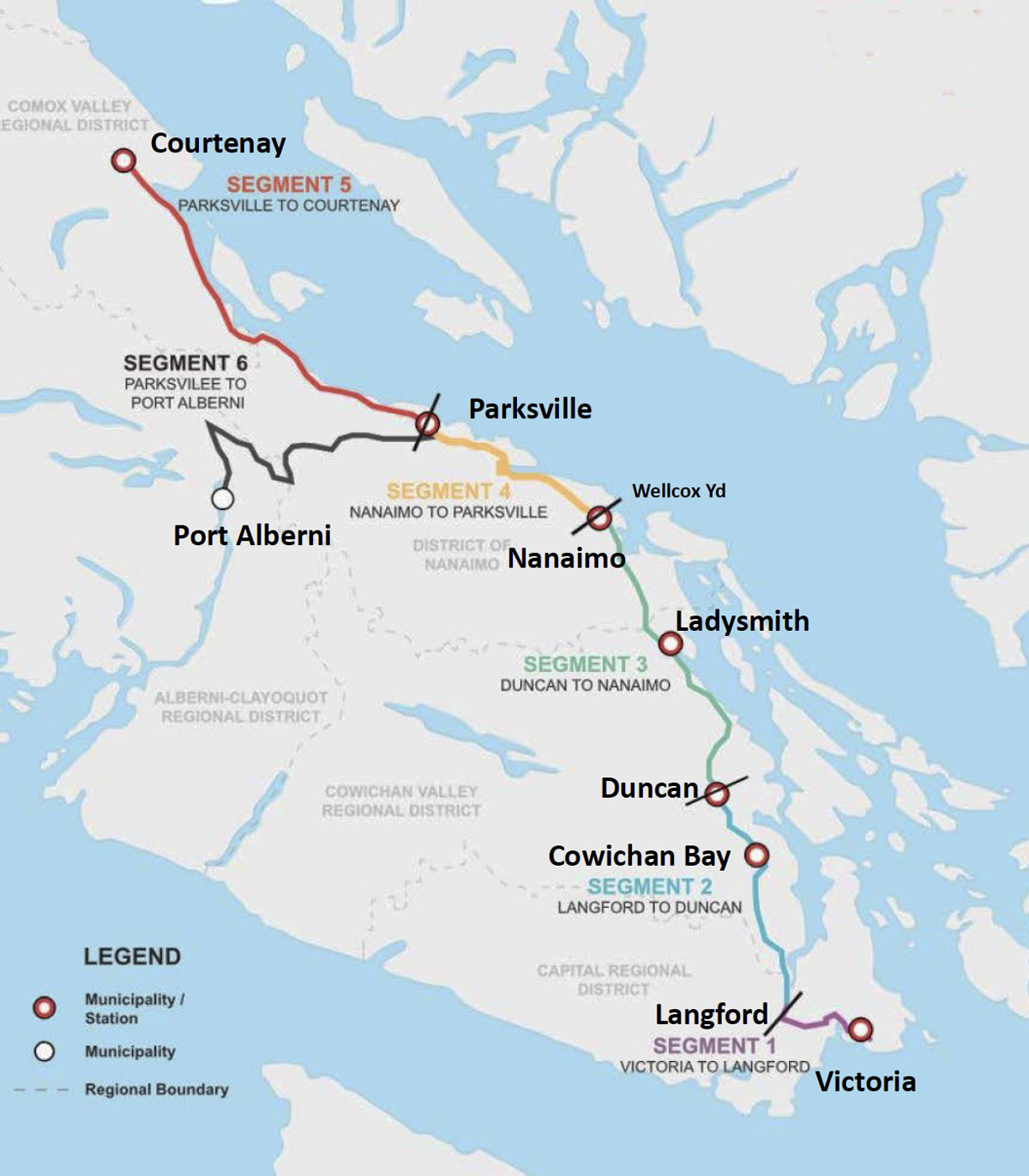E&N 9023 RDC Train 1 at Victoria, BC on November 10, 1969.
As the population of the Island increases and the traffic gets more congested, restarting train service on the Island Rail Corridor seems like a no-brainer. But let's consider this carefully:

The E&N was built for low-speed transportation
The railway was built in the 1870’s to carry coal more efficiently than in horse drawn wagons. An act of Parliament allowed it to be built cheaply with tighter curves and steeper grades than were normally allowed. This means the maximum allowable speed on the tracks is about 65 km/hr, eliminating any kind of rapid transit on the existing corridor even if the rails were replaced.

Rebuilding the tracks will be expensive
Given the above constraints it could easily cost over $1 billion to create a train that would be fast and frequent enough to attract a viable ridership. A report commissioned by the Ministry of Transport in 2020 put the cost of one train per day, traveling at only 55 kmh over the Malahat, at close to $400 million. With current inflation rates that figure would be substantially higher now, for a train that would not be used. There are better uses for that money.

The train will probably be diesel-powered

The train will not really eliminate traffic
A consultant studying the Malahat found the train would carry just 1% of the traffic on the Malahat for an operating subsidy of $1 million a year. This demand could be met by express buses at half the cost without the massive costs of rebuilding a Victorian era railway. Rather than spend hundreds of millions on rail let's buy hundreds of electric buses to lessen traffic and lower the impact on the climate.
Are you just cranky train haters? No. Many FORT-VI members long advocated for rail service to be renewed on the Island Rail Corridor. Eventually they realised that rebuilding the tracks was prohibitively expensive and impractical. While politicians delayed, the corridor was falling into corrosion and decay. If sufficient funding ever becomes available and a solid business case is made, FORT-VI is not opposed to switching the trail to a train line again.
FAQ about renewing rail service
 The main section of the Island Rail Corridor is 225 kilometres long from Victoria to Courtenay. A branch line stretches from Parksville to Port Alberni and is 64 kilometres long for a total of 289 km of mainline track.
The main section of the Island Rail Corridor is 225 kilometres long from Victoria to Courtenay. A branch line stretches from Parksville to Port Alberni and is 64 kilometres long for a total of 289 km of mainline track.
- 225 km rail corridor from Victoria to Courtenay (207 km from Langford to Courtenay)
- 64 km spur from Parksville to Port Alberni
- 5 Regional Districts and 14 First Nations
- 67 Bridges and Trestles
- 236 level crossings

Passenger service between Courtenay and Victoria stopped in 2011. The service was discontinued due to safety concerns about the quality of the tracks and the stability of many bridges along the line.
When the passenger service was running, VIA Rail provided an annual subsidy of $1.4 million due to low ridership.
A limited amount of industrial freight transport still continues on a short section of the tracks near Nanaimo.
No. According to the 1994 Supreme Court case between British Columbia (Attorney General) v. Canada (Attorney General) on whether Canada owes BC a constitutional obligation to ensure operation of rail service between Victoria and Nanaimo the ruling was that "Canada does not owe a constitutional obligation to British Columbia in respect of the operation of the Victoria to Nanaimo Vancouver Island rail line." See the Supreme Court of Canada Report 1994 [2SCR 41]
First Nations are crucially important on this issue and must be involved in decisions of how to manage the rail right of way for the future.
The history of rail construction on First Nations land is not pleasant. In many cases, the E&N railroad cut directly through the First Nations reserves, dividing their already small allotments and creating noise pollution in the community.
We have been in touch with various First Nations leaders about their opinion of renewed rail service. Some First Nations wish to have the rail lands given back to their reserve and others prefer an unbroken corridor. Ten acres of the Corridor were recently returned to the Snaw-Naw-As First Nation following their court case. Representatives from several First Nations sit on the Island Corridor Foundation (ICF) board, which owns the corridor, but five of them resigned recently when the board narrowly voted down their motion to look at alternative uses for the corridor.

No. The current condition of the tracks and railbed has deteriorated to the point that much of it is unusable. Furthermore, the Island Rail Corridor was designed for 19th Century low-speed freight transport of logs and coal.
The track is particularly curvy and has to reduce speed to cross roads or driveways in more than 230 locations. The E&N tracks were simply not made for bullet trains!
Estimates vary but all agree that rebuilding the full railway will incur significant expense. According to a 2020 BC Ministry of Transportation and Infrastructure report, costs for the intermediate case include:
- $377 Million in estimated costs for Langford to Courtenay
Cost per Kilometer: $1.8 Million for just one train per day - $145 Million in estimated costs for Parksville to Port Alberni
Cost per km: $2.3 Million
This level of spending seems inordinate relative to other budgetary priorities at a local, provincial and federal level.
Relatedly, any profits from freight use of a restored railway are obligated to a US company, Southern Rail of Vancouver Island (SVI), and will not remain in the community.
Probably not. The original railway is curvy and was designed for low speed freight transportation in the 19th Century and is unsuitable for higher-speed commuter use.
The maximum allowable speed is 65 km per hour, slowing to 30 kmh on sections of the Malahat.* When passenger rail service was in operation, it took 90 minutes longer than driving the total route due to speed restrictions (uncontrolled crossings, track conditions, etc).
The initial phase would have travel time from Victoria to Courtenay at 5hr 11min (30 mph / 65 km/h). Completely rebuilding the tracks would improve these lengthy travel times to 3h 8min averaging 50mph / 80 km/h. This would be at great expense, and still not offer significant time savings compared to car or even electric bus transportation, especially if not point to point at locations on the track.
* Island Rail Corridor Condition Assessment, Ministry of Transportation and Infrastructure, March 2020 (WSP)
Yes, but electrification was considered too costly in 2020 provincial studies.
Electrification was deemed too costly in Appendix I of the Island Rail Corridor Condition Assessment (March, 2020). Whether overhead lines (catenary system) or a third rail, the passenger and freight numbers did not warrant the expense.
Battery-powered trains may be available in the future, but likely no sooner than widespread electrically powered trucks and buses. The more plausible scenario is that the trains will run on diesel fuel, continuing to generate greenhouse gas emissions.
Unlikely. The South Island Transportation Study showed much better greenhouse gas reduction by buses on bus lanes between Langford and Vic West. Buses north over the Malahat would likely also show much better greenhouse gas reduction than diesel trains because of the higher frequency and flexibility of buses, encouraging greater ridership. The number of electric cars is growing rapidly, and will soon be mandated, and electric buses will soon be operating.
